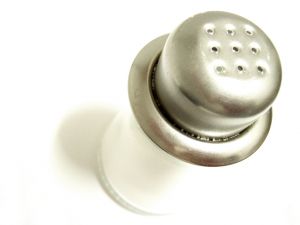By Kac Young PhD, ND, DCH
Continued from part 1 of this article…..
 You can reduce your sodium intake if you:
You can reduce your sodium intake if you:
1. Cook at home from scratch and reduce the amount of salt you add to dishes.
2. Check labels for sodium in all its forms. Table salt is mainly sodium chloride, but canned or packaged foods can contain other forms of sodium.
3. In the kitchen and at the dinner table, substitute spices, herbs, and salt-free blends for salt.
4. When you do opt for packaged foods, choose products that are sodium free or low in sodium. A typical cup of miso soup, for instance, contains 700 to 900 milligrams of sodium, so look for canned soups with “low sodium” or “reduced sodium” on the label. Bread and cereals carry loads of sodium. Buy the lowest sodium kind you can find and avoid white flour brands.
5. Watch out for salad dressings, ready- made pasta sauces, cup-o-soup products, canned vegetables, frozen pizzas, sausages, pepperoni, canned tuna, and pretty much any food that requires preservation or shelf life.
6. In a restaurant, ask your waiter which dishes are the lowest in sodium and ask of the chef can prepare yours without adding salt.
The overall best approach is to scan the ingredient list before eating or drinking anything. Any ingredient with “sodium” or “Na” — the chemical name for sodium — in its name contains the substance. Sodium might also be labeled as baking soda, baking powder, monosodium glutamate (MSG), disodium phosphate or salt.
Sugar
Astonishingly, Americans consume an estimated 130 pounds of added sugar per capita annually. That’s about 22 teaspoons daily for adults; roughly 32 teaspoons children (almost three-fourths of a cup). Topping the added-sugar intake list are soft drinks, accounting for 33 percent of added sugar consumed daily.
Overconsumption of added sugar and high-glycemic carbohydrates (like those found in breads, pizza, cold cereals and other baked goods) has been linked to obesity, diabetes and cardiovascular disease.
One of the most effective things you can do to improve your health is to cut back radically on sugar consumption; in particular, avoid sugared beverages entirely. If this seems overwhelming, taper off slowly – add slightly less sugar to your coffee or tea every day and start by drinking fewer soft drinks per week, etc. You will quickly discover that the craving for sugar dissipates. Foods that once seemed pleasantly sweet begin to taste sickly sweet .
Steer clear of artificial sweeteners – they have chemical components and adverse long term health consequences and the best solution is to choose natural sweeteners like organic raw sugar, maple syrup, or fruit sauces (apple or pear) and cut way back on quantity and portion size.
If you reduce your consumption of Bad saturated fats, salt and sugar you will be on your way to a healthier body, a leaner frame, more energy and you will reduce your risk for heart disease, stroke, obesity and diabetes.
– Kac Young has earned three doctorate degrees: a Ph.D in Natural Health, a Doctorate in Naturopathy and a Doctorate in Clinical Hypnotherapy. She is a spiritual counselor, a teacher, and a licensed Religious Science minister. Her books: “21 Days to the Love of Your Life”; “Discover Your Spiritual Genius”; “Dancing With the Moon,” “Feng Shui the Easy Way,” “Gold Mind,” “Heart Easy,” “The Path to Fabulous,” “Cheese Dome Power,” “The Quick Guide to Bach Flower Remedies,” and “Supreme Healing,” are designed to give the reader tools for self improvement.
[1] Conducted by an international team led by Dr. Dariush Mozaffarian of Harvard University’s School of Public Health, was published Aug. 13, 2014 in the New England Journal of Medicine.
